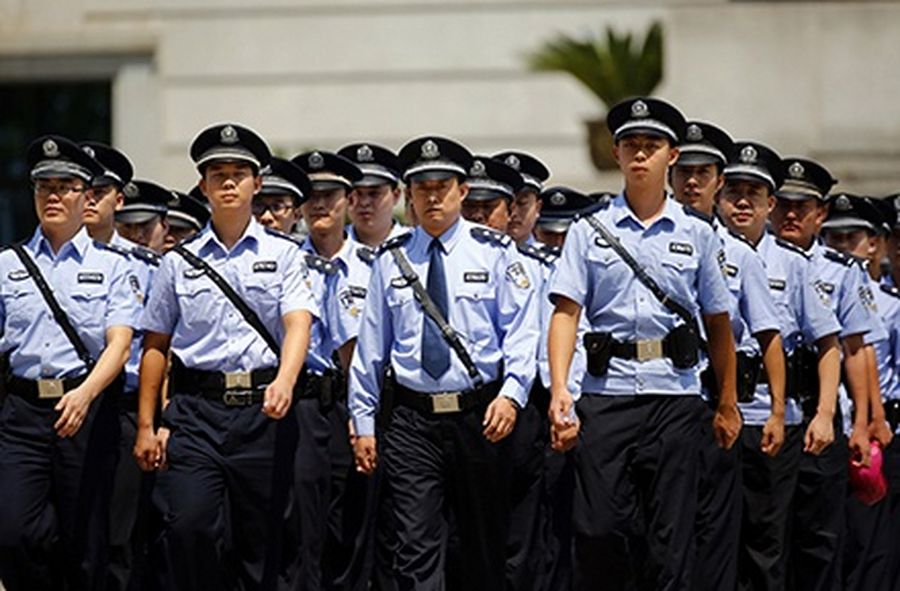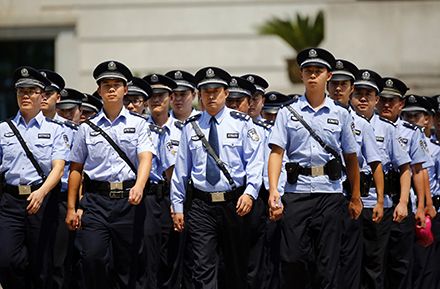The domestic bond market in China is undergoing a dramatic transformation as officials continue to introduce new products to relieve the pressure on bank lending.

Financial revolution
Source: REUTERS/Carlos Barria
Policemen march outside a court where the trial of disgraced Chinese politician Bo Xilai was held in Jinan, Shandong.
Regulators in the PRC are looking to open up China’s domestic bond markets to more issuers and investors as they seek to keep the country’s economy growing, while reining in bank lending.
Key reforms followed the third plenary session of the Chinese Communist Party’s central committee in November, and the pace of change is expected to quicken in 2014.
“Beijing will likely accelerate the implementation of the grand reform plan that emerged from the Third Plenum,” Qu Hongbin, HSBC’s chief economist for China, said in a research note.
The plan calls for interest rate liberalisation, capital account liberation, changes to the structure of the bond markets and a range of new products.
While Beijing has underlined its determination to develop China’s domestic financial markets, implementing the reforms will be a complex process, involving layers of regulators and competing stakeholders.
China’s banks, for example, are having a tough time issuing the planned Rmb327.7bn (US$53.8bn) of Tier 2 bonds to meet tougher capital requirements under Basel III.
China adopted Basel III at the start of 2013, but the People’s Bank of China has been slow to grant approvals. Only two lenders have issued T2 debt totalling just Rmb3bn.
Bankers suspect the PBoC is stalling on approvals as part of an ongoing effort to force the banking sector to deleverage, restricting the growth of off-balance sheet financing and limiting bad loans.
The growing backlog of T2 bonds, however, is putting Chinese lenders under pressure to find alternative sources of capital. That has opened the door for the country’s first hybrid securities, instruments that can be count as Additional T1 capital.
Panda politics
The China Securities Regulatory Commission unveiled rules for preferred shares in mid-December in a big step towards issuing the country’s first hybrid securities. The rules, which allow both listed and unlisted companies to sell preferred shares for the first time since the 1980s, took effect in January.
China’s decision to allow German automaker Daimler to issue medium-term notes also marks a step forward for reforms.
To date, only supranationals and state-backed financial institutions have issued so-called Panda bonds, but Daimler is set to be the first foreign corporation to gain direct access to the onshore capital market.
The National Association of Financial Market Institutional Investors, which oversees the MTN market, has been leading the push for innovative products. Late last year it approved GD Power’s sale of perpetual MTNs – China’s first undated corporate bond. The Rmb1bn fixed-rate bond, callable every five years, priced to yield 6.6%.
China’s pilot municipal bond programme is also attracting much attention, as the country looks to deal with a growing burden of local government debt, which stood at Rmb17.9trn in 2013, according to the National Audit Office. Most of this debt was in the form of bank loans and off-balance sheet financing because only a handful of local governments had been allowed to issue municipal bonds in the past.
Similarly, the first negotiable certificates of deposit in China’s interbank bond market, launched in mid-December, hinted at the development of a broader range of interest-rate products. As well as opening a new source of liquidity for banks, NCDs are expected to lead to a transparent, market-based gauge of deposit rates.
Market-set rates
The emergence of NCDs opens a new source of liquidity for banks and also paves the way for the PBoC’s eventual removal of interest rate controls.
“It is likely that the interbank NCD is just the prelude for a broader NCD that can be sold directly to corporates and individuals,” May Yan, head of banks sector research for Asia ex-Japan at Barclays wrote in a client note.
Deposit rates are still subject to an upper limit, but the PBoC introduced a market-set loan prime rate in July 2013 as an alternative to the its own lending benchmark. The change allows issuers to price loans and bonds within a broader range than allowed previously.
China’s pilot securitisation programme has also expanded with an additional Rmb300bn quota, on top of Rmb17bn agreed in 2012, leading market participants to expect a slew of ABS issues this year. China’s first auto loan ABS, an offering from Volkswagen Finance, is expected to be among the deals.
The issuers also will include China Development Bank, which sold Rmb8bn in railway loan ABS under the new quota last November. CDB has received permission to issue a total of Rmb100bn of such securities, according to market sources.
CDB, China’s biggest policy bank, has another honour under its belt, as the first institution to issue exchange-traded bonds.
The Rmb30bn deal marks a key step towards unifying China’s two bond markets, the Rmb22.48trn interbank market, which the PBoC regulates, and the much smaller Rmb0.46trn exchange-traded market under the CSRC.
In another effort to deepen the US$4trn domestic bond markets, the government is opening the door, albeit slowly, to foreign investors.
In October, the government expanded the renminbi qualified foreign institutional investor pilot programme with more flexible investment guidelines. The Rmb270bn scheme is now available to approved investors in London, Hong Kong, Taiwan and Singapore.
To see the digital version of this report, please click here.
